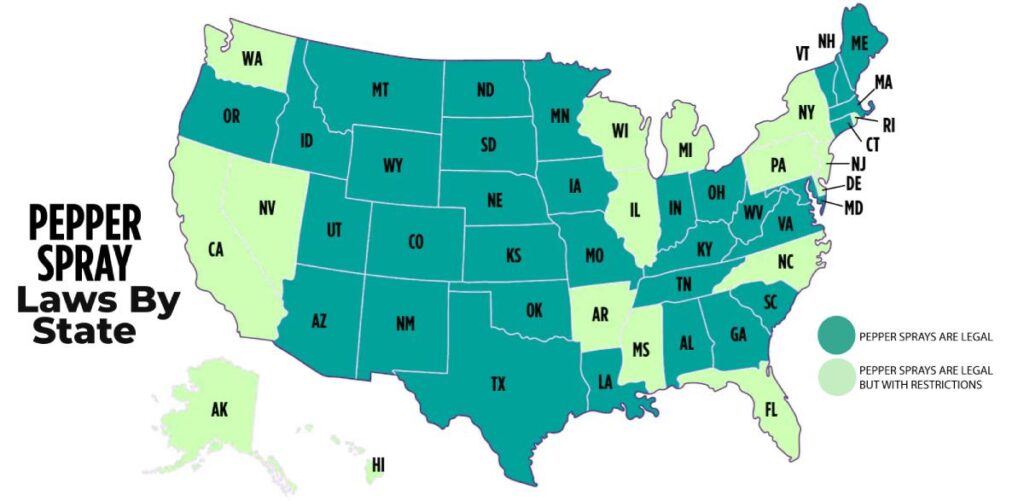Table of Contents
- State Regulations Impacting OC Spray Formulations
- Comparing Maximum Permissible Concentrations Across States
- Legal Considerations for Carrying OC Spray in Public
- Best Practices for Choosing OC Spray Based on Local Laws
- In Summary
State Regulations Impacting OC Spray Formulations
The landscape of self-defense regulations varies widely across U.S. states, directly influencing the permissible concentration of oleoresin capsicum (OC) spray in commercially available formulations. States such as California and New York impose stricter limits, capping the OC concentration to ensure both public safety and effective deterrence. Conversely, states like Texas and Florida adopt more lenient stances, allowing higher concentrations in their products. These regulatory decisions often reflect a balance between law enforcement recommendations and consumer protection, impacting both manufacturers and users in the self-defense market.
Understanding these state-specific parameters requires careful attention to the following factors:
- Maximum OC concentration allowed – ranges typically from 5% to 10% OC content
- Legal restrictions on spray delivery systems – some states regulate nozzle designs and spray patterns
- Permit and possession guidelines – compliance often hinges on whether a license or permit is required
- Restrictions on sales and carrying – age limits and retail seller compliance are state-dependent
By navigating these regulatory nuances, consumers can make informed choices that comply with the laws of their state while maintaining personal safety. For manufacturers, staying compliant means aligning product development and marketing with the dynamic regulatory environment that varies not only by state but sometimes by municipality within the states.
Comparing Maximum Permissible Concentrations Across States
When navigating the legal landscape of OC spray usage, it’s essential to recognize that concentration limits vary significantly from one state to another. Some states permit formulations with up to 10% OC concentration, catering largely to personal defense products, while others enforce much stricter limits around 2% to 5%. These differences reflect diverse legislative approaches balancing public safety concerns with individual rights. For instance, states like California and New York maintain tighter regulations, emphasizing lower maximum allowed concentrations, whereas others such as Texas tend to be more lenient, permitting higher potency formulas.
Below are typical maximum concentration thresholds you’ll encounter across various regions:
- California: Up to 2.5%
- Texas: Up to 10%
- Florida: Around 5%
- New York: Strictly capped at 3%
- Illinois: Generally between 5% and 7.5%
Understanding these distinctions is crucial for compliance, especially for manufacturers, retailers, and law enforcement agencies operating across state lines. Always verify the local statutes before purchasing or distributing OC spray to avoid potential legal issues.
Legal Considerations for Carrying OC Spray in Public
When carrying OC spray, it’s essential to understand that legal restrictions vary widely across different states. Some states impose strict concentration limits on the active ingredient-the oleoresin capsicum-dictating the maximum allowed percentage to ensure public safety. Violating these limits can result in hefty fines or even criminal charges. Besides concentration caps, several jurisdictions regulate the quantity you can carry, the container size, and require spray devices to have specific labeling or safety mechanisms. Additionally, some states restrict the possession of OC spray by certain groups, such as minors or convicted felons.
Beyond concentration and quantity, there are also restrictions on how and where OC spray can be used or carried. For instance, it may be prohibited in specific public venues like government buildings, schools, or airports. States may also mandate that OC sprays be used exclusively for self-defense, not as offensive weapons. To navigate the complex legal landscape, consider the following:
- Verify the maximum allowable OC spray concentration and container size in your state.
- Check for any licensing or age requirements before purchasing or carrying.
- Understand locations where OC spray possession or use is prohibited.
- Keep informed about local updates, as laws can change frequently.
Best Practices for Choosing OC Spray Based on Local Laws
When selecting an OC spray, understanding the precise legal restrictions in your state is crucial to avoid penalties and ensure responsible use. Many states impose limits not only on the overall concentration of oleoresin capsicum but also on factors such as spray stream type, canister size, and intended use. For instance, some jurisdictions only permit sprays below a certain percentage of active ingredient concentration, while others specify limits on the carrier substance or require the product to be explicitly labeled for self-defense. Before making a purchase, it’s wise to consult official state government or law enforcement websites for updated statutes and regulations, as these guidelines can vary widely and may change over time.
Keep these key considerations in mind when shopping for OC spray:
- Concentration limits: Most states cap OC spray strength between 0.18% and 10% active capsaicin compounds.
- Device specifications: Some laws restrict canister size, spray range, and spray pattern to prevent misuse.
- Licensing requirements: A few states mandate permits or training courses before purchasing or carrying pepper spray legally.
- Age restrictions: Buyers may need to be over a certain age, often 18 or 21, to purchase and carry OC spray.
- Usage prohibitions: Know where the spray can and cannot be carried, such as schools, airports, or government buildings.
In Summary
Navigating the patchwork of state regulations on OC spray concentration can be challenging, but staying informed is essential for responsible use and legal compliance. Whether you’re a consumer, retailer, or law enforcement professional, understanding these limits ensures you’re equipped with the right knowledge to make safe, lawful decisions. Keep this guide handy as a reference, and always check for updates in your state’s laws-because when it comes to personal safety, being well-informed is your best defense. Thanks for reading, and stay safe out there!Check Our Other Blogs
- StunGun – Your Trusted Source for Stun Guns, Laws, and Self-Defense Tips
- PepperSprayLaws – Your Trusted Resource for Pepper Spray Information
- StunGunLaws – Your Trusted Guide to Stun Gun Legality and Safety




